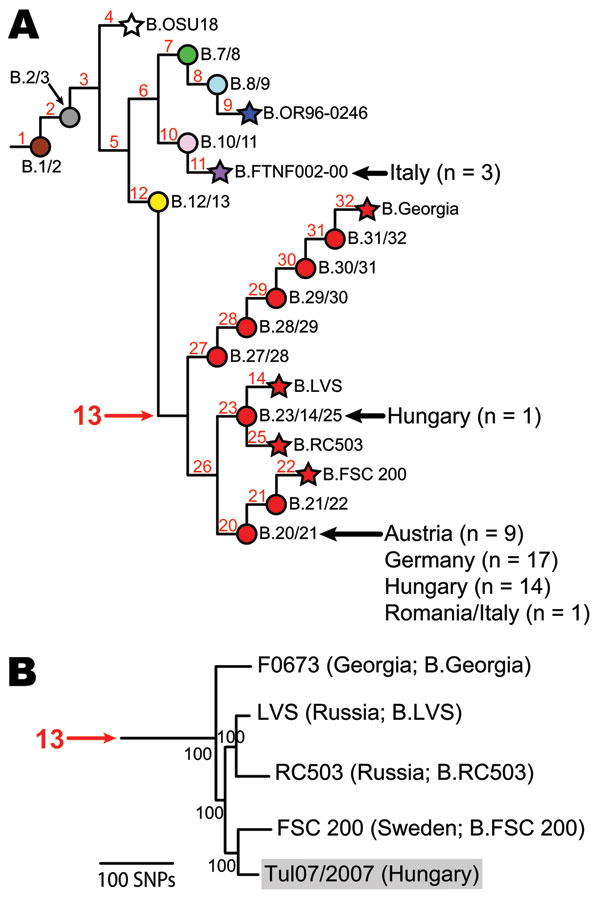Volume 18, Number 2—February 2012
Dispatch
Phylogeography of Francisella tularensis subsp. holarctica, Europe
Figure 1

Figure 1. Existing phylogeny of Francisella tularensis subsp. holarctica. A) Single nucleotide polymorphism (SNP)–based phylogeny of F. tularensis subsp. holarctica derived from previous studies (5,6,8). Terminal subgroups representing sequenced strains are shown as stars, and intervening nodes representing collapsed branches are indicated by circles. Subclades within group B.13 are depicted in red. Isolates from Austria, Germany, Hungary, Italy, and Romania (n = 45) were assigned to existing subclades (black arrows) by using existing canonical SNP assays (5,8). B) Maximum parsimony phylogeny constructed by using SNPs discovered from 6 F. tularensis whole-genome sequences, including 5 strains from group B.13 and an outgroup strain, OSU18 (not shown). This phylogeny was rooted by using OSU18, and bootstrap values were based on 1,000 simulations by using a heuristic search. The newly sequenced Hungarian strain (Tul07/2007) is highlighted in gray.
References
- Dennis DT, Inglesby TV, Henderson DA, Bartlett JG, Ascher MS, Eitzen E, Tularemia as a biological weapon: medical and public health management. JAMA. 2001;285:2763–73. DOIPubMedGoogle Scholar
- Rotz LD, Khan AS, Lillibridge SR, Ostroff SM, Hughes JM. Public health assessment of potential biological terrorism agents. Emerg Infect Dis. 2002;8:225–30. DOIPubMedGoogle Scholar
- Keim P, Johansson A, Wagner DM. Molecular epidemiology, evolution, and ecology of Francisella. Ann N Y Acad Sci. 2007;1105:30–66. DOIPubMedGoogle Scholar
- Keim PS, Wagner DM. Humans and evolutionary and ecological forces shaped the phylogeography of recently emerged diseases. Nat Rev Microbiol. 2009;7:813–21. DOIPubMedGoogle Scholar
- Vogler AJ, Birdsell D, Price LB, Bowers JR, Beckstrom-Sternberg SM, Auerbach RK, Phylogeography of Francisella tularensis: global expansion of a highly fit clone. J Bacteriol. 2009;191:2474–84. DOIPubMedGoogle Scholar
- Chanturia G, Birdsell DN, Kekelidze M, Zhgenti E, Babuadze G, Tsertsvadze N, Phylogeography of Francisella tularensis subspecies holarctica from the country of Georgia. BMC Microbiol. 2011;11:139. DOIPubMedGoogle Scholar
- Pilo P, Johansson A, Frey J. Identification of Francisella tularensis cluster in central and western Europe. Emerg Infect Dis. 2009;15:2049–51. DOIPubMedGoogle Scholar
- Svensson K, Granberg M, Karlsson L, Neubauerova V, Forsman M, Johansson A. A real-time PCR array for hierarchical identification of Francisella isolates. PLoS ONE. 2009;4:e8360. DOIPubMedGoogle Scholar
- Vogler AJ, Birdsell DN, Lee J, Vaissaire J, Doujet CL, Lapalus M, Phylogeography of Francisella tularensis ssp. holarctica in France. Lett Appl Microbiol. 2011;52:177–80. DOIPubMedGoogle Scholar
1These authors contributed equally to this article.